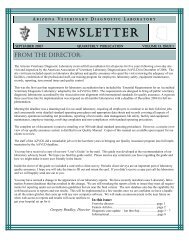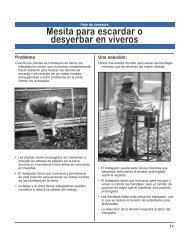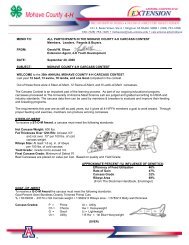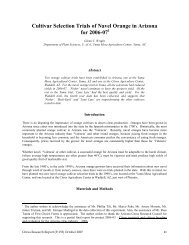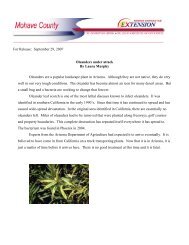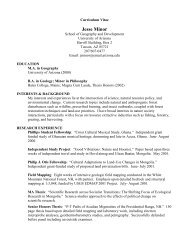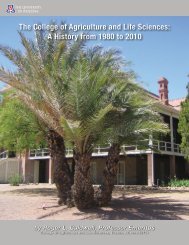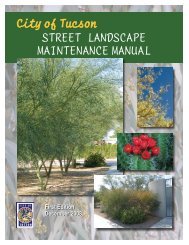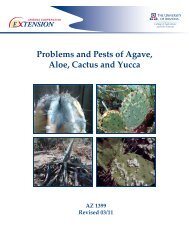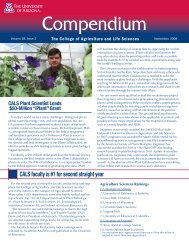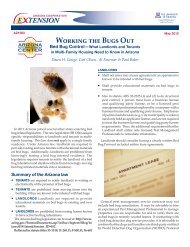Mesquite and Palo Verde Trees - University of Arizona
Mesquite and Palo Verde Trees - University of Arizona
Mesquite and Palo Verde Trees - University of Arizona
Create successful ePaper yourself
Turn your PDF publications into a flip-book with our unique Google optimized e-Paper software.
Prosopis chilensis (Chilean mesquite)<br />
Figure 2: Leaf <strong>of</strong> Prosopis chilensis<br />
This mesquite is characterized by a lacy crown <strong>of</strong> bluegreen<br />
foliage on spiny stems (Fig. 2). Spines may be up<br />
to 2 inches (5 cm) in length which may limit its use in<br />
residential or high traffic areas. The trunk is typically dark<br />
brown <strong>and</strong> fissured. In the low <strong>and</strong> mid-desert, below<br />
2,500 feet (762 meters), the tree will lose most <strong>of</strong> its foliage<br />
except in years <strong>of</strong> mild winter temperatures when foliage<br />
may remain on the tree until March. Old leaves do not fall<br />
from the tree until new growth is well underway. During<br />
cold winters the tree will be dormant <strong>and</strong> leafless for 6<br />
– 8 weeks during winter. New foliage will appear in late<br />
March or early April <strong>and</strong> is fern-like <strong>and</strong> a beautiful light<br />
green. Leaves are characterized by 1 – 3 pairs <strong>of</strong> pinnae<br />
each with 10 – 29 pairs <strong>of</strong> widely spaced leaflets. Flowers<br />
are 1 – 3 inches (2.5 - 7.6 cm) in length <strong>and</strong> light yellow.<br />
Flowers are followed by 2 – 5 inch (5 – 13 cm) bean pods<br />
that ripen in July.<br />
Prosopis gl<strong>and</strong>ulosa var. gl<strong>and</strong>ulosa (Texas honey mesquite)<br />
Figure 3: Leaf <strong>of</strong> Prosopis gl<strong>and</strong>ulosa var. gl<strong>and</strong>ulosa<br />
This attractive ornamental tree grows to a mature height<br />
<strong>of</strong> 15 – 30 feet (5 – 10 meters) <strong>and</strong> is characterized by its<br />
weeping habit <strong>and</strong> shiny foliage which resembles Schinus<br />
molle (California pepper tree). It has small reddish thorns<br />
<strong>and</strong> creamy white flowers. Leaves have 1 – 2 pairs <strong>of</strong> pinnae<br />
with 6 – 17 pairs <strong>of</strong> secondary leaflets per pinna (Fig. 3). The<br />
2 The <strong>University</strong> <strong>of</strong> <strong>Arizona</strong> Cooperative Extension<br />
trunk is tan <strong>and</strong> smooth when young but becomes rougher<br />
<strong>and</strong> darker as the tree matures. Texas honey mesquite is<br />
native to the southwestern U.S. including Texas, Oklahoma,<br />
Kansas <strong>and</strong> into northern Mexico.<br />
Due to its ornamental popularity, several selections<br />
have been made for foliage, form <strong>and</strong> thornlessness. These<br />
cultivars are vegetatively propagated to insure the integrity<br />
<strong>of</strong> the clone. Texas honey mesquites require well drained<br />
soil <strong>and</strong> tolerate full sun or partial sun. Once established,<br />
plants irrigated monthly develop into larger trees with a<br />
dense canopy.<br />
Figure 4: Leaf <strong>of</strong> Prosopis gl<strong>and</strong>ulosa var. torreyana<br />
P. gl<strong>and</strong>ulosa var. torreyana is similar in character to Texas<br />
honey mesquite, but has smaller leaves with one pair <strong>of</strong><br />
pinnae <strong>and</strong> 8 – 24 pairs <strong>of</strong> leaflets per pinna (Fig. 4). It is<br />
native to west Texas, California, New Mexico <strong>and</strong> parts <strong>of</strong><br />
<strong>Arizona</strong> <strong>and</strong> Mexico. This variety can sometimes be found<br />
in nurseries.<br />
Prosopis nigra (Black mesquite, Algarrobo negro)<br />
Figure 5: Leaf <strong>of</strong> Prosopis nigra



